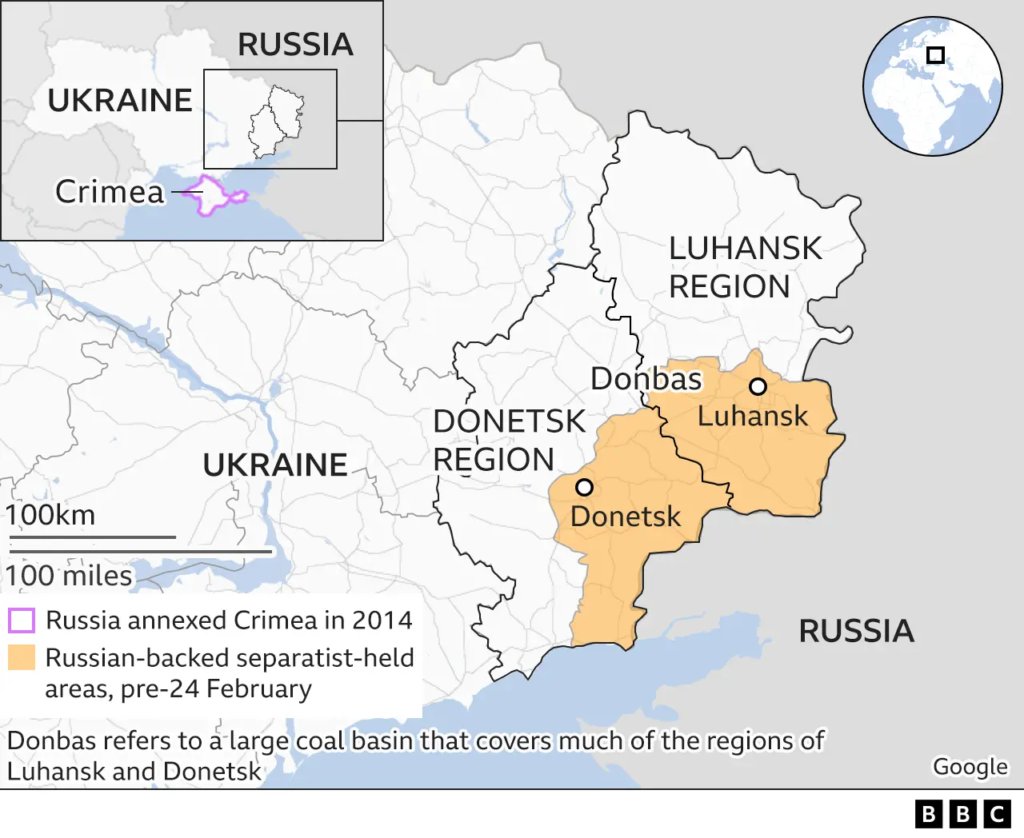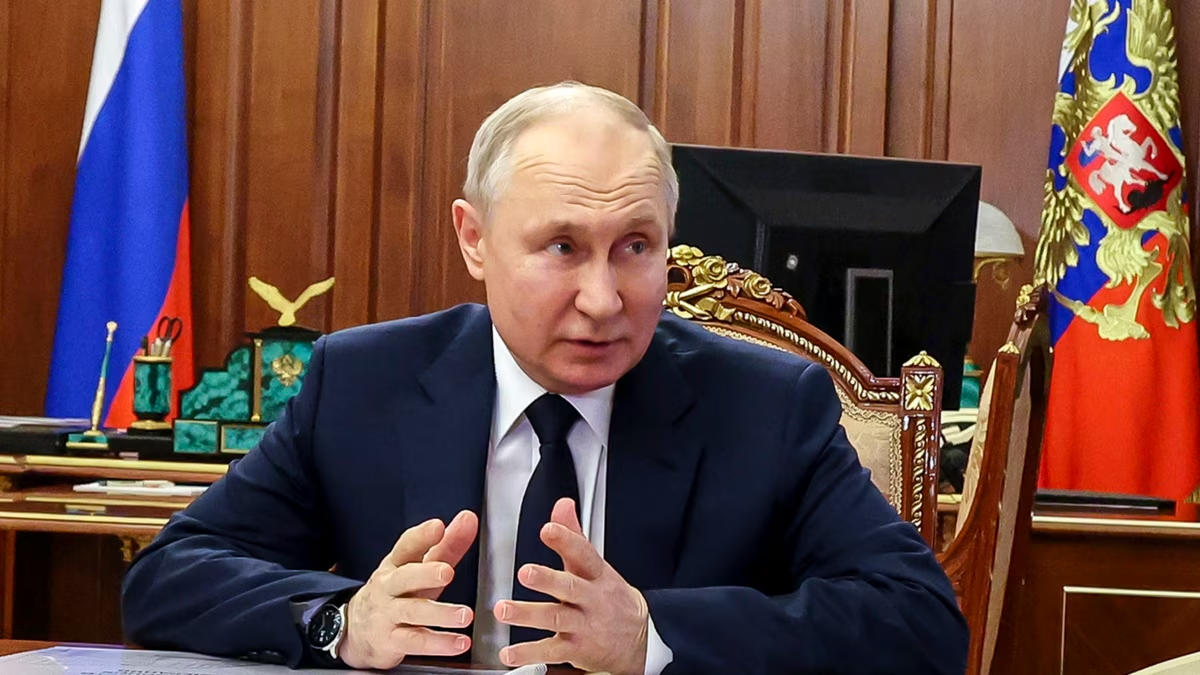Donbas has become the focal point of Russia’s military campaign in Ukraine, as President Vladimir Putin reaffirmed that Russia’s main objective in the ongoing war is to gain full control over this eastern Ukrainian region.
As the war stretches into its 30th month, Putin emphasized that despite Ukraine’s counter-offensives, particularly in Kursk, Russia remains focused on the region, and their operations there have gained momentum.
From the beginning of the conflict, Donbas has been a strategically significant region for both Ukraine and Russia. The Donbas region, which includes Donetsk and Luhansk, has been the site of pro-Russian separatist movements since 2014. Moscow’s ongoing efforts to take control of Donbas have intensified in recent months, with Russian forces making noticeable advances.
Russia’s Strategic Shift Toward Donbas
In February 2022, when Russia launched its full-scale invasion of Ukraine, its primary goal appeared to be a swift capture of the Ukrainian capital, Kyiv. However, the resistance from Ukrainian forces and logistical challenges forced Moscow to recalibrate its approach.
A region with significant industrial assets and a majority Russian-speaking population, became the new focus of Russian military efforts. Putin’s recent statements underscore this shift, as he declared that the main goal of the invasion is the “liberation” of Donbas.
The region has long been a hotspot in Ukraine-Russia relations. Following Russia’s annexation of Crimea in 2014, separatists in Donetsk and Luhansk declared independence from Ukraine, leading to years of conflict between Ukrainian forces and Russian-backed rebels.

Moscow’s determination to solidify its control over the region is part of a broader strategy to create a land corridor connecting Russia to Crimea and the southern Ukrainian regions under its control.
Putin’s Recent Remarks on Donbas
In a speech given at a forum in Vladivostok, President Putin emphasized that despite Ukraine’s counter-offensive in Kursk, the situation in the region remains Russia’s primary objective.
According to Putin, Ukraine’s efforts in Kursk have inadvertently facilitated Russia’s progress in the region, as Kyiv had weakened its own forces by deploying well-prepared units away from the eastern frontlines. Putin’s claim is that these Ukrainian deployments in Kursk have allowed Russian forces to accelerate their offensive operations in Donbas.
“The aim of the enemy (in Kursk) was to force us to worry, hustle, divert troops, and to stop our offensive in key areas, especially in Donbas, the liberation of which is our main primary objective,” Putin said.
This statement leaves no doubt about Moscow’s intent to push deeper into Ukrainian-held territories in the region, continuing to occupy and consolidate its control over key cities and towns.
Russia’s Gains in Donbas
Throughout the summer of 2024, Russian forces have made significant gains in the region. According to reports, they are now within a dozen kilometers of Pokrovsk, a crucial logistical hub in eastern Ukraine.
The proximity of Russian forces to Pokrovsk has triggered mass evacuations as thousands of civilians flee the advancing army. This advance comes on the back of months of heavy fighting and sustained military operations by Moscow’s troops in the Donbas region.
The strategic importance of the region for Russia cannot be overstated. By controlling Donbas, Russia not only strengthens its grip on a resource-rich part of Ukraine but also creates a contiguous land bridge to Crimea, further isolating Ukraine from its southeastern regions. With the control of Donbas, Moscow would hold a significant geopolitical and economic advantage in the region.
Ukraine’s Resistance and Kursk Incursion
Ukraine, however, is not conceding the region without a fight. The Ukrainian military continues to hold significant portions of Donetsk and Luhansk, resisting Russian advances in critical areas.
President Volodymyr Zelensky has repeatedly stressed that Ukraine will defend its territories, including Donbas, against Russian aggression. Zelensky also highlighted the importance of Ukraine’s counter-offensives, particularly in Kursk, in testing Russia’s defenses.
While Putin claimed that Ukraine’s push into Russia’s Kursk region was aimed at diverting Russian forces from the region, Ukraine’s leadership sees it as an important operation to expose Russia’s vulnerabilities.
Zelensky remarked in an interview with NBC that Kyiv’s aim in Kursk was to “show Russians what is more important to him (Putin): occupation of the territories of Ukraine or the protection of his population.” The incursion into Kursk, although significant in terms of the scale and impact on Russian soil, has not slowed down Russia’s operations in Donbas, according to Putin.
The Importance of Donbas for Russia and Ukraine
For Russia, Donbas holds not only economic and strategic significance but also symbolic importance. Moscow has long framed its invasion of Ukraine as a “liberation” of Russian-speaking populations in eastern Ukraine, particularly in the region. Capturing the region would fulfill one of Russia’s major political and military goals, allowing it to claim success in its so-called “special military operation.”
On the other hand, for Ukraine, the region is a critical region that it cannot afford to lose. Its control over Donbas is crucial for maintaining territorial integrity and preventing further Russian encroachment.
The Ukrainian government views any loss of the region as a blow to national sovereignty and an encouragement of further Russian aggression. Hence, the battle for the region continues to be one of the most intense and important theaters of the war.
Casualties and Humanitarian Impact in Donbas
The human toll of the ongoing conflict in the region is staggering. Both Russian and Ukrainian forces have sustained heavy casualties as they fight for control of the region.
Civilian populations have borne the brunt of the violence, with shelling and missile strikes causing widespread destruction of homes, infrastructure, and essential services. In Ukraine’s Donetsk region alone, a 74-year-old man was recently killed when a Russian shell hit his home in the town of Kostyantynivka.
On the Russian side, casualties have also been reported as a result of Ukrainian shelling in border regions like Belgorod, highlighting the continuing tit-for-tat nature of the conflict. The prolonged fighting in Donbas has created a humanitarian crisis, with tens of thousands of people displaced, seeking refuge in safer areas.
The destruction of towns and cities in the region is a reminder of the cost of this war, and both sides continue to engage in heavy artillery exchanges that devastate the region.
Putin’s Vision for Donbas
Putin’s vision for the region is clear: complete control over the region and its integration into the Russian Federation. Russia has already claimed four Ukrainian regions, including Donetsk and Luhansk in Donbas, as part of its territory.
Although this claim is not recognized by the international community, Moscow continues to press ahead with its plans for annexation. Putin has repeatedly framed the war in Ukraine as a “holy duty” to protect Russian-speaking populations in Donbas and other areas, using this narrative to justify Russia’s aggression.
In his Vladivostok speech, Putin reiterated that it is the “holy duty of the Russian army to do everything to throw out the enemy from this territory and to protect our citizens.” This rhetoric underscores the ideological underpinnings of Russia’s war in Ukraine and highlights the central role that Donbas plays in Moscow’s strategic calculations.
Negotiations and the Future of Donbas
While Putin remains steadfast in his objective of controlling Donbas, there have been occasional signals that Moscow might be willing to negotiate, albeit on its own terms. Putin suggested that Russia is open to talks, but only if Kyiv accepts the annexation of Donetsk, Luhansk, Zaporizhzhia, and Kherson regions. He referenced a purported peace deal negotiated in Istanbul in 2022, though the details of that agreement were never made public.
Ukraine, however, has made it clear that any negotiations must involve the restoration of its territorial integrity, including Donbas. Zelensky’s government has repeatedly stated that it will not accept any deal that cedes Ukrainian territory to Russia. Kyiv’s leadership is committed to holding on to Donbas and ensuring that it remains part of Ukraine’s sovereign territory.
Donbas remains at the heart of the Ukraine-Russia conflict, with both sides unwilling to compromise on its future. For Russia, Donbas is the cornerstone of its military and political strategy in Ukraine, and Putin has made it clear that controlling the region is the primary goal of Moscow’s ongoing operations.
On the other hand, Ukraine views Donbas as an integral part of its national territory and is determined to defend it against Russian aggression.
As the war drags on, the battle for Donbas will likely intensify, with both Ukrainian and Russian forces continuing to engage in fierce combat. The future of Donbas remains uncertain, but one thing is clear: it will play a crucial role in shaping the outcome of this devastating conflict. The stakes are high, and neither side is willing to back down in the fight for control of Donbas.
let’s enjoy few years on earth with peace and happiness….✍🏼🙏

